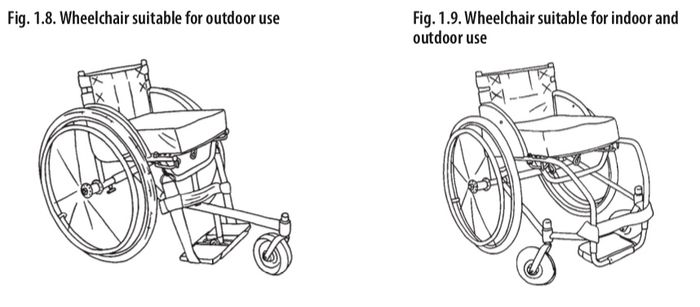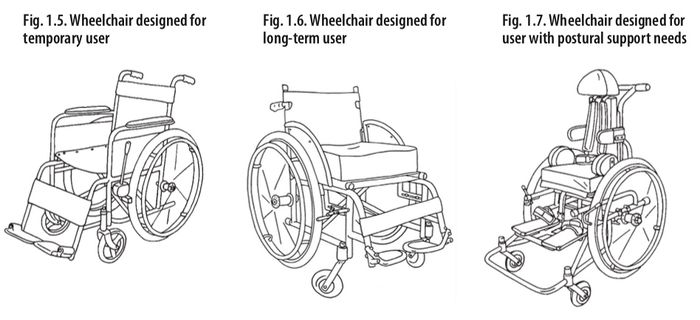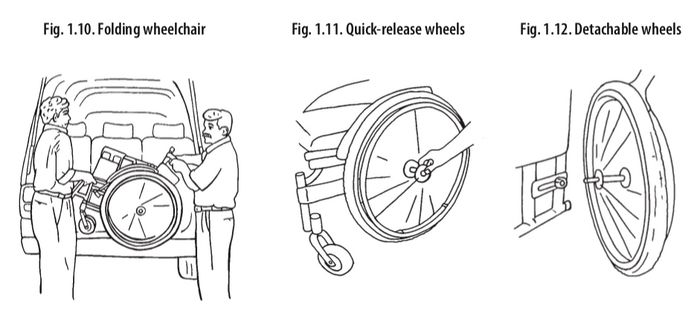Types of Wheelchair
Original Editor - Naomi O'Reilly as part of the Wheelchair Service Provision Content Development Project
Top Contributors - Naomi O'Reilly, Kim Jackson, Shaimaa Eldib, Admin and Amrita Patro
Introduction[edit | edit source]
There are a wide variety of types of wheelchair, differing by propulsion method, mechanisms of control, and technology used. Some wheelchairs are designed for general everyday use, others for single activities, or to address specific access needs. No single model or size of wheelchair can meet the needs of all users, and the diversity among users creates a need for different types of wheelchair. Those selecting wheelchairs, in consultation with the user, need to understand the physical needs of the intended user and how they intend to use the wheelchair, as well as knowledge of the reasons for different wheelchair designs.
Manual Wheelchairs[edit | edit source]
Wheelchair Frames[edit | edit source]
The composition of the frame is a key factor in the functionality of the wheelchair. The steel being the most usual, is the heaviest but also the cheapest. A wheelchair with aluminium frame is much lighter and then much easier to propel, but also more expensive. You can also find frames made of very light materials like specific aluminium, titanium and carbon. They are commonly used in rigid frame wheelchairs and have a very high price.
The frame of a wheelchair can also be either rigid (fixed), or foldable. The energy efficiency for the user to propel is double in a wheelchair with a rigid frame, taking an average of 15-20% of the impulse, while a folding wheelchair only uses on average of 5 - 8% of the impulse.
Both rigid frame and folding wheelchairs have advantages and disadvantages. The best choice will depend on the wheelchair users lifestyle, how they transfer in and out of transport and their personal preference.
Folding Frame[edit | edit source]
The folding frame types of wheelchairs consist of a folding X Style Frame. Most frames fold when the locking mechanism is released for folding and tend to include removable foot rests which allow for easy folding. Most frames are made from aluminum or titanium and are heavier than the rigid frame. As with anything with moveable parts, the folding wheelchair is not as durable as the rigid frame wheelchair. Therefore maintenance is required more frequently to keep all parts in good working order. Similarly, in a folding wheelchair, part of the propulsion energy is lost in movements within its structure and all points of articulation.
Rigid Frame[edit | edit source]
A rigid frame wheelchair consists of a single welded frame on which the individual sits. This can incorporate either a fixed back rest or a folding back rest where the back of the chair is able to fold down. It also incorporates wheels can be removed with a quick release mechanism to enable easy storage and transportation of the wheelchair. In most cases these frames are lightweight and are made from either aluminum or titanium, and in some cases from carbon fiber, A lightweight rigid frame wheelchair can weigh as little as 10 lbs without the wheels.
The advantage of these types of wheelchairs: are that they have fewer moving parts, which means they are generally stronger and last longer than the folding wheelchair. Other advantages for the rigid frame is that it is easy to handle and is somewhat lighter than one similar folding wheelchair. However, the folding wheelchair is generally more comfortable for transport and storage by occupying less space.Sports Wheelchairs[edit | edit source]
Just as other sports require participants to use certain equipment and skills, wheelchair sports require a certain set of equipment and skills. There are a wide range of sports developed for wheelchair users including Archery, basketball, boccia, dancing, racing, rugby, and tennis. Whether a beginner looking to start playing a wheelchair sport, those with advanced skills, or professional athletes, there are a huge range of sports wheelchairs available depending on the sport and the level at which the user plays. The wheelchairs used for each sport have evolved to suit the specific needs of that sport and often no longer resemble their everyday cousins. They are usually non-folding (in order to increase rigidity), with a pronounced negative camber for the wheels (which provides stability and is helpful for making sharp turns), and often are made of composite, lightweight materials. Even seating position may be radically different, with racing wheelchairs generally used in a kneeling position. Sport wheelchairs are rarely suited for everyday use, and are often a 'second' chair specifically for sport use, although some users prefer the sport options for everyday. Some disabled people, for instance lower-limb amputees, may use a wheelchair for sports, but not for everyday activities.
Multi-Sport Wheelchair[edit | edit source]
Motivation’s Multisports Wheelchair, has been designed for a wide range of users, from school children to adults. The affordable Multisport Wheelchair, is a fraction of the price of ‘Professional’ or 'Specialist Sport Specific' Wheelchairs and yet can compete almost at the same level and is designed to make sport accessible to people with a disability. There are two models, which suit basketball, tennis and no doubt other sports and activities.
The main design features of the chair are;
- adjustable backrest, ensuring that it fits a range of sizes;
- quick release wheels;
- inclined / angled wheels, add to the stability of the wheelchair, especially during sporting activities;
- adjustable back wheel, also called the caster, adding stability;
- lightweight frame manufactured from common tubular steel;
- highly manoeuvrable, allowing it to used successfully in sporting activities.
- robust and strong, able to withstand the type of rough treatment, that occurs in wheelchair sports.
- removable toe guard at the front, keeps the users feet out of harms way.
Sport Specific Wheelchair[edit | edit source]
Wheelchair Basketball[edit | edit source]
Wheelchair basketball, played by two teams of five players, is a fast-paced game where the object is to shoot the ball into the opposing team’s basket. Each team is comprised of five players and up to seven substitutes. A game consists of four periods of ten minutes. The basic rules of wheelchair basketball are very similar to running basketball with minor adjustments to meet the needs of the game in a wheelchair. The primary piece of equipment in the game of wheelchair basketball is the wheelchair, which has evolved over time alongside the development of the sport and technology. When wheelchair basketball was first played, players just used their everyday wheelchair which were often very heavy, while today wheelchair basketball chairs are specifically developed for the sport, are constructed with aluminium or titanium making them lightweight and streamlined to allow for speed and agility with many cutting-edge, sport-enhancing design features. Basketball Wheelchairs are designed for enhanced stability and mobility and now include an additional fifth and sixth wheel anti-tip devices. The front bumper is designed so that it will not lock with or be held by the opponent. The angle of the wheel base or “camber” is optimal for each athlete to allow for stability and quick turns. Guards have lower seats and therefore greater stability for ball handling and getting down the court as quickly as possible in comparison to Centers and Forwards whose chairs have higher seats and therefore less mobility, but the height increases the player's reach for shots at the hoop and for rebounds and meets their role which is typically underneath the net.
Wheelchair Racing[edit | edit source]
Wheelchair racing includes both track and road races. At Paralympic level there are wheelchair racing track events in: 100m, 200m, 400m, 800m, 1500m, 5000m, 10000m and relay races 4x100m and 4x400m. There is also the marathon out on the road. Track Tech Explained - Racing Wheelchairs
Watch this video about the technology used by wheelchair paralympians
Wheelchair Rugby[edit | edit source]
Wheelchair Rugby is a mixed team sport for male and female quadriplegic athletes. A unique sport created by athletes with a disability, it combines elements of rugby, basketball and handball. Players compete in teams of four to carry the ball across the opposing team's goal line. Contact between wheelchairs is permitted, and is in fact an integral part of the sport as players use their chairs to block and hold opponents. Wheelchair Rugby players compete in manual wheelchairs specifically designed for the sport. The rules include detailed specifications for wheelchairs to ensure safety and fairness. In international competition, all wheelchairs must meet these requirements.
Wheelchair Tennis[edit | edit source]
Wheelchair tennis, founded in 1976 when Brad Parks, follows the same rules as running tennis, as endorsed by the International Tennis Federation, with the only exception being that the wheelchair tennis player is allowed two bounces of the ball. The 'two-bounce rule' is written into the Rules of Tennis. A Tennis wheelchair is lighter than everyday chairs to allow the athlete flexibility of movement, making the game more spectacular. The wheelchair is considered part of the player - therefore, general rules of contact apply. To keep the player stable on the chair, a positioning strap across the waist and/or thighs is used. Wheelchair tennis has improved dramatically in recent years due in large part to technological advancements.
Wheels:
- Wheels should be light and rigid.
- Radial spoking wheels are best for wheelchair tennis.
- Some of the top players are playing in wheelchairs with two small wheels at the front and an anti tip bar at the rear.
- Camber, or the angling of the chairs wheels, has also been introduced to the tennis wheelchair. Camber aids the wheelchair tennis player by enhancing side to side balance and stability, increasing security, and enhancing turn speed.
Frames:
- Newer chairs frames are manufactured with lightweight and more durable materials such as aluminium, and titanium.
- Today’s tennis wheelchair can weigh anywhere between 8-15 kilograms.
- Wheelchair tennis chairs can be either custom built or fully adjustable. Adjustable chairs are recommended, especially for beginner players.
Tyres:
- Tyres are crucial for wheelchair tennis. Weight in the tyres, especially the push rim, directly relates to the power required to set that wheel in motion.
- Lighter materials are currently being tested in the push rim as well as the spokes.
References[edit | edit source]
- ↑ NHS Choices. Looking Beyond the Standard Wheelchair. Available from: https://youtu.be/GHQo1xBphMY [last accessed 6/6/2018]
- ↑ Gold Pictures. The Manual Wheelchair Comparision: Chair Shopping. Available from: https://www.youtube.com/watch?v=Zk30X1oujao&t=331s [last accessed 6/6/2018]
- ↑ Gold Pictures. The Manual Wheelchair Comparison: Pediatric Chairs. Available from: https://youtu.be/qH3TxciH-og?list=PLv0O9I4DD6_X0WBOnMg-pl4GomOZfE8Pt [last accessed 6/6/2018]
- ↑ Ottobock. Sport and Everyday Life in a Wheelchair. Available from: https://www.youtube.com/watch?v=Qpfa0rbscdQ&t=32s [last accessed 6/6/2018]
- ↑ Motivation Charity. Assembling your Motivation Multisport Wheelchair. Available from: https://youtu.be/Ip3RYO1WW_I [last accessed 6/6/2018]
- ↑ Paralympics Games. Paralympic Sports A-Z: Wheelchair basketball. Available from: https://www.youtube.com/watch?v=0RWvXzYKoHM&t=14s [last accessed 6/6/2018]
- ↑ MA. Wheelchair Basketball Equipment at Invictus Orlando 2016. Available from: https://www.youtube.com/watch?v=TnLhUJ1uRj0 [last accessed 6/6/2018]
- ↑ Paralympics Games. Paralympic Sports A-Z: Wheelchair Rugby. Available from: https://www.youtube.com/watch?v=tSzFmlWgVsM&t=9s [last accessed 6/6/2018]
- ↑ MA. Wheelchair Rugby Equipment at Invictus Orlando 2016. Available from: https://www.youtube.com/watch?v=dAMxv08Ki4U [last accessed 6/6/2018]
- ↑ Paralympics Games. Paralympic Sports A-Z: Wheelchair Tennis. Available from: https://www.youtube.com/watch?v=uKTdxygcat4 [last accessed 6/6/2018]
- ↑ United States Tennis Association (USTA). Introduction to USTA Wheelchair Tennis: Equipment. Available from: https://www.youtube.com/watch?v=OktRBQzUccA&t=9s [last accessed 6/6/2018]









